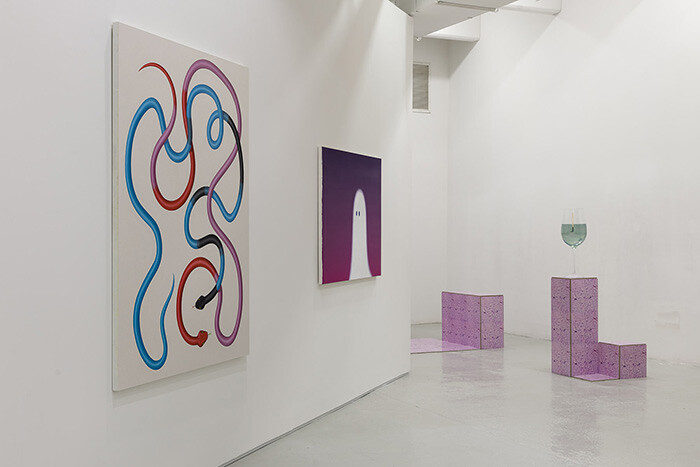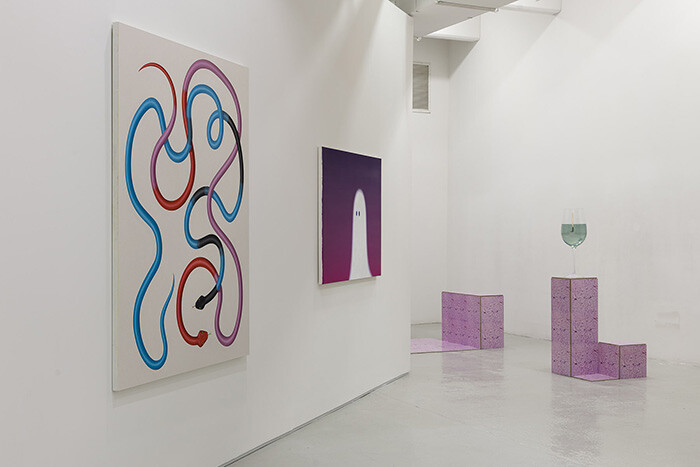It’s hard to find much affection for art fairs. Aside from their unvarnished commercialism, they are, after all, why some gallerists never see their children/partners/ornamental budgerigars. However, Independent—a fair that has taken place in New York every March since 2010 to coincide with the Armory show—has induced warm feelings over the years, rising through the old sun-lit Dia building in Chelsea. At a time when galleries, collectors, and critics alike were losing faith in the Armory’s bald, depressing, trade-fair approach, Independent stepped in with proof of life and experimentation in the fair game: freeform design, heavy European participation, and not-for-profit collaboration brought playful experimentation at a moment when things were feeling scarily dead on the piers.
Capitalizing on these successes, this year Independent attempted to switch it up once more, adding an autumn show with Independent Projects, which not only went it alone without a mega fair in town to support it (though New York’s Contemporary and Modern auctions do take place within its run), but also proposed that the fair be devoted only to artists’ solo projects, and that it should transform into an “exhibition” after an initial “fair weekend.” Gallerists, desks, and iPads would disappear and be replaced by student docents. The absence of competition opened the door for some unexpected participation by a handful of top-tier galleries with New York operations, including Gagosian Gallery, David Zwirner, Dominique Lévy, Lisson Gallery, and Gavin Brown’s Enterprise. So, we were presented with something of a salpicón: blue chips were thrown into this mixture of a fair, exhibition, and “curatorial platform,” carrying the explanation that “outsider” work would be emphasized, thereby softening the presence of the high rollers. No longer confined to galleries who see one another as peers, the mix seemed to speak more about protocols of taste than that of previous years.
This quiet fair certainly had a different atmosphere from previous manifestations, though the exhibition design was elegant as usual, privileging occasional walls that cut through the space diagonally, punctuating the building without chopping it into dreaded “booths.” Respects were paid to historic, or reanimated works by radical elders. A previously unrealized Yves Klein, Sculpture Tactile (1957/2014), was on view at Dominique Lévy, New York, next to Klein’s smaller, original mockup (to provide legitimacy, presumably). Visitors were invited to reach their hands into a large bird-box-like construction, realizing, sometimes with a shriek, that they were touching the naked skin of a human being hiding inside. A deeply uncanny sensation slowly settles and sticks after the initial shock, for when one can’t place which body part has been touched, only a memory of floating, warm skin in the dark can be fathomed. Gavin Brown’s Enterprise, New York, showed Joan Jonas’s After Mirage (1976/2011/2014), a ring of tall, white aluminum cones displayed alongside footage of windows playing on a monitor on the floor. Venus Over Manhattan, New York, showed David Medalla’s Cloud Canyons (1963), a series of thick, clear Perspex tubes, out of which white foam slowly blooms and falls, whilst Massimo de Carlo, Milan and London, presented Gianfranco Baruchello, an Italian artist now in his nineties (b. 1924), whose work emphasizes delicate intricacies and spindly networks via sculptures full of honeycomb-like constructions assembled from book pages. Nearby, New York’s Skarstedt Fine Art’s presentation of Mike Kelley’s quasi-religious felt banners, such as Devils Bush (1988)—a series of thick stripes in school tie colors—served as a backdrop to an ornamental plant guarded by two orange, benignly smiling devil bears. Queasily pleasing as these works always are in their emphasis on the coexistence of homespun warmth and institutional creepiness, here they positioned a posthumous Kelley uncomfortably as a historic, canonized outsider artist, hanging politely on mourning grey walls.
There was less emphasis on outsider practice from the younger galleries who ordinarily form the bedrock of Independent, and though there were plenty of polite paintings on show, strong sculptural statements fared best, managing to claim energy from the quiet atmosphere, and often providing commanding displays using feats of material ingenuity. Private and public space, as mediated by the body, was raised often subtly by artworks on the third floor: Berlin’s Galerie Neu showed Yngve Holen’s heavily gothic triad of 3D-scanned meat hunks carved in veiny Italian marble and laid on strips of airplane flooring, elevated to recall hospital trollies. At Jonathan Viner, London, Nicolas Deshayes’s aluminum panels (Untitled, 2014)—of the kind used on the London Underground signage—picture the photographic torsos of waiting individuals against colored backdrops in the helpful hues of municipal space—green, blue, red, and pink—accompanied by occasional globules of liquids or smears suggesting episodes of illness, violence, sexual encounters, or accidents, while Prem Sahib’s palely tiled pillars affixed with slick black twists of glass tubing (Watch Queen Instinct, 2014) relatedly summon sexual encounters in nightclub bathrooms. At Croy Nielsen, Berlin, visual metaphors run amok in Nina Beier’s installation Ruse Addiction Eruption Plunge (2014), in which visual metaphors found in stock photography are scaled up and brought into three dimensions. Her large, modular arrangements of cubes, decorated with lilac tiles featuring a cracked ceramic pattern, were topped with a pile of charred wood and a selection of oversized cocktail glasses filled with a clear resin, as well as fish, pharmaceuticals, and a hammer cracking an egg—surreal clichés preserved like latter-day mosquitos in amber. Nearby, Berlin’s Société displayed a more domestically located form of disturbance with a pair of Bunny Rogers’s Columbine-toned dressing gowns (or perhaps mourning robes?), which hang beneath a bookcase (Untitled, 2014). The presence of allover aesthetic patterning, thick silk ribbons tied in bows, and spectrally silvery, cartoonish appliqué give the work with a sense of ritual strangeness—that perhaps the late Kelley would have appreciated—whilst draping them in a velvet sadness.
Independent’s most glaring problem was its eerie lack of visitors, spelling attendant rumblings about slow sales. One would have to conclude that the March edition’s successes have relied—more heavily than the organizers had reckoned with—on the clout of an established behemoth like the Armory to fan collectors into town. In Mathew Cerletty’s painting On the Move (2014), a gleaming white ghost set against a smooth red-to-purple gradient stares out, confused, as though looking off-camera for some direction. Shown by Jay Gorney, a dealer who currently operates without a gallery space, it was something of an existential mirror for Independent Projects: its expression reflected that of gallerists and staffers alike, who often appeared lost for anyone to talk to. And like the fair it was bright, surprising, uncanny—and alarmed to find itself a little bit dead.











